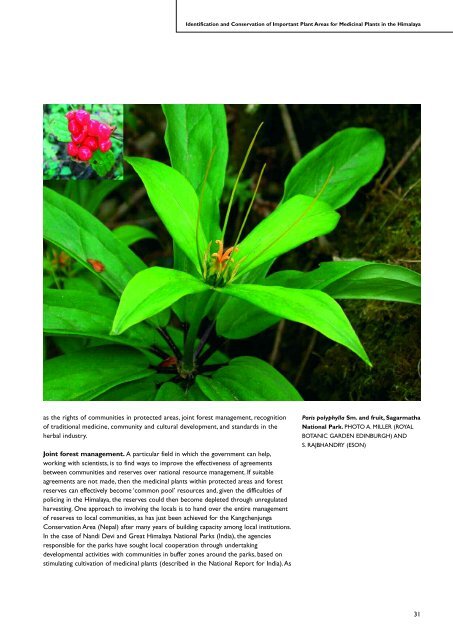Identification and Conservation of Important Plant Areas - Plantlife
Identification and Conservation of Important Plant Areas - Plantlife
Identification and Conservation of Important Plant Areas - Plantlife
- No tags were found...
You also want an ePaper? Increase the reach of your titles
YUMPU automatically turns print PDFs into web optimized ePapers that Google loves.
<strong>Identification</strong> <strong>and</strong> <strong>Conservation</strong> <strong>of</strong> <strong>Important</strong> <strong>Plant</strong> <strong>Areas</strong> for Medicinal <strong>Plant</strong>s in the Himalayaas the rights <strong>of</strong> communities in protected areas, joint forest management, recognition<strong>of</strong> traditional medicine, community <strong>and</strong> cultural development, <strong>and</strong> st<strong>and</strong>ards in theherbal industry.Joint forest management. A particular field in which the government can help,working with scientists, is to find ways to improve the effectiveness <strong>of</strong> agreementsbetween communities <strong>and</strong> reserves over national resource management. If suitableagreements are not made, then the medicinal plants within protected areas <strong>and</strong> forestreserves can effectively become ‘common pool’ resources <strong>and</strong>, given the difficulties <strong>of</strong>policing in the Himalaya, the reserves could then become depleted through unregulatedharvesting. One approach to involving the locals is to h<strong>and</strong> over the entire management<strong>of</strong> reserves to local communities, as has just been achieved for the Kangchenjunga<strong>Conservation</strong> Area (Nepal) after many years <strong>of</strong> building capacity among local institutions.In the case <strong>of</strong> N<strong>and</strong>i Devi <strong>and</strong> Great Himalaya National Parks (India), the agenciesresponsible for the parks have sought local cooperation through undertakingdevelopmental activities with communities in buffer zones around the parks, based onstimulating cultivation <strong>of</strong> medicinal plants (described in the National Report for India).AsParis polyphylla Sm. <strong>and</strong> fruit, SagarmathaNational Park. PHOTO A. MILLER (ROYALBOTANIC GARDEN EDINBURGH) ANDS. RAJBHANDRY (ESON)31
















